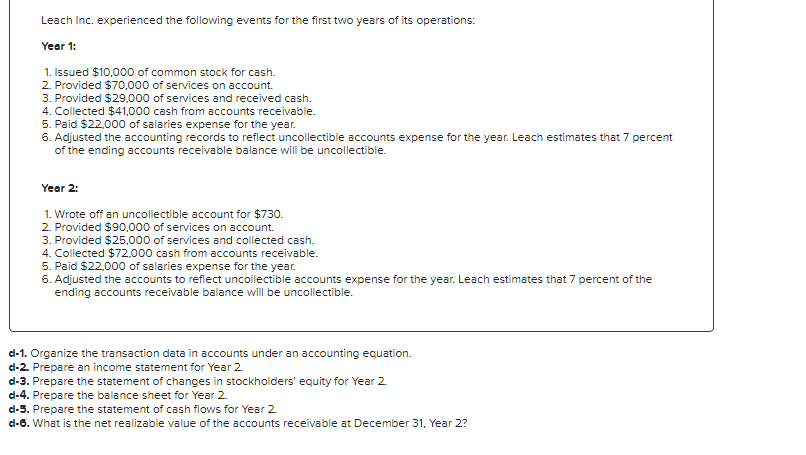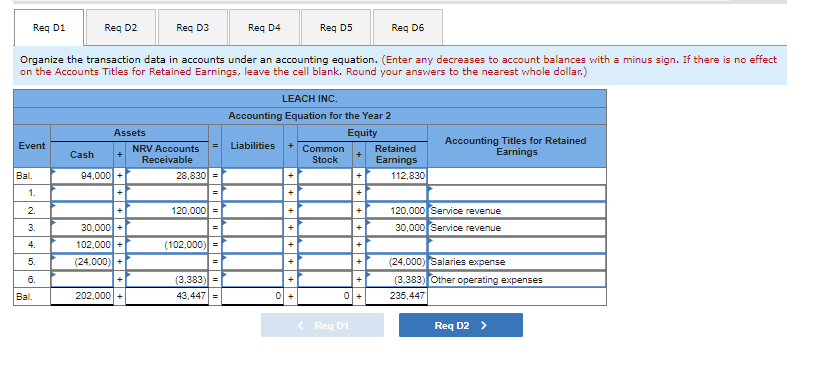Leach Inc. experienced the following events for the first two years of its operations: Year 1: Issued $10,000 of common stock for cash. Provided $70,000 of services on account. Provided $29,000 of services and received cash. Collected $41,000 cash from accounts receivable. Paid $22,000 of salaries expense for the year. Adjusted the accounting records to reflect uncollectible accounts expense for the year. Leach estimates that 7 percent of the ending accounts receivable balance will be uncollectible. Year 2: Wrote off an uncollectible account for $730. Provided $90,000 of services on account. Provided $25,000 of services and collected cash. Collected $72,000 cash from accounts receivable. Paid $22,000 of salaries expense for the year. Adjusted the accounts to reflect uncollectible accounts expense for the year. Leach estimates that 7 percent of the ending accounts receivable balance will be uncollectible.
Leach Inc. experienced the following events for the first two years of its operations: Year 1: Issued $10,000 of common stock for cash. Provided $70,000 of services on account. Provided $29,000 of services and received cash. Collected $41,000 cash from accounts receivable. Paid $22,000 of salaries expense for the year. Adjusted the accounting records to reflect uncollectible accounts expense for the year. Leach estimates that 7 percent of the ending accounts receivable balance will be uncollectible. Year 2: Wrote off an uncollectible account for $730. Provided $90,000 of services on account. Provided $25,000 of services and collected cash. Collected $72,000 cash from accounts receivable. Paid $22,000 of salaries expense for the year. Adjusted the accounts to reflect uncollectible accounts expense for the year. Leach estimates that 7 percent of the ending accounts receivable balance will be uncollectible.
Financial Reporting, Financial Statement Analysis and Valuation
8th Edition
ISBN:9781285190907
Author:James M. Wahlen, Stephen P. Baginski, Mark Bradshaw
Publisher:James M. Wahlen, Stephen P. Baginski, Mark Bradshaw
Chapter2: Asset And Liability Valuation And Income Recognition
Section: Chapter Questions
Problem 20PC: Analyzing Transactions. Using the analytical framework, indicate the effect of the following related...
Related questions
Question
Leach Inc. experienced the following events for the first two years of its operations:
Year 1:
- Issued $10,000 of common stock for cash.
- Provided $70,000 of services on account.
- Provided $29,000 of services and received cash.
- Collected $41,000 cash from
accounts receivable . - Paid $22,000 of salaries expense for the year.
- Adjusted the accounting records to reflect uncollectible accounts expense for the year. Leach estimates that 7 percent of the ending accounts receivable balance will be uncollectible.
Year 2:
- Wrote off an uncollectible account for $730.
- Provided $90,000 of services on account.
- Provided $25,000 of services and collected cash.
- Collected $72,000 cash from accounts receivable.
- Paid $22,000 of salaries expense for the year.
- Adjusted the accounts to reflect uncollectible accounts expense for the year. Leach estimates that 7 percent of the ending accounts receivable balance will be uncollectible.

Transcribed Image Text:Leach Inc. experienced the following events for the first two years of its operations:
Year 1:
1. Issued $10,000 of common stock for cash.
2. Provided $70,000 of services on account.
3. Provided $29,000 of services and received cash.
4. Collected $41.000 cash from accounts receivable.
5. Paid $22,000 of salaries expense for the year.
6. Adjusted the accounting records to reflect uncollectible accounts expense for the year. Leach estimates that 7 percent
of the ending accounts receivable balance will be uncollectible.
Year 2:
1. Wrote off an uncollectible account for $730.
2. Provided $90,000 of services on account.
3. Provided $25,000 of services and collected cash.
4. Collected $72.000 cash from accounts receivable.
5. Paid $22,000 of salaries expense for the year.
6. Adjusted the accounts to reflect uncollectible accounts expense for the year. Leach estimates that 7 percent of the
ending accounts receivable balance will be uncollectible.
d-1. Organize the transaction data in accounts under an accounting equation.
d-2. Prepare an income statement for Year 2.
d-3. Prepare the statement of changes in stockholders' equity for Year 2
d-4. Prepare the balance sheet for Year 2.
d-5. Prepare the statement of cash flows for Year 2
d-6. What is the net realizable value of the accounts receivable at December 31, Year 2?

Transcribed Image Text:Reg D1
Reg D2
Reg D3
Reg D4
Req D5
Req D6
Organize the transaction data in accounts under an accounting equation. (Enter any decreases to account balances with a minus sign. If there is no effect
on the Accounts Titles for Retained Earnings, leave the cell blank. Round your answers to the nearest whole dollar.)
LEACH INC.
Accounting Equation for the Year 2
Assets
Equity
Accounting Titles for Retained
Earnings
Event
NRV Accounts
Liabilities
Common
Retained
Cash
Receivable
Stock
Earnings
Bal.
94,000 +
28,830 =
112,830
1.
2.
120,000 =
120,000 Service revenue
30,000+
30,000 Service revenue
3.
4.
102,000 +
(102,000) =
5.
(24,000) +
(24,000) Salaries expense
6.
(3,383)
(3,383) Other operating expenses
Bal.
202,000 +
43,447|=
235,447
< Req D1
Req D2 >
+++
++
+ ++ ++ + +
Expert Solution
This question has been solved!
Explore an expertly crafted, step-by-step solution for a thorough understanding of key concepts.
This is a popular solution!
Trending now
This is a popular solution!
Step by step
Solved in 2 steps with 8 images

Knowledge Booster
Learn more about
Need a deep-dive on the concept behind this application? Look no further. Learn more about this topic, accounting and related others by exploring similar questions and additional content below.Recommended textbooks for you

Financial Reporting, Financial Statement Analysis…
Finance
ISBN:
9781285190907
Author:
James M. Wahlen, Stephen P. Baginski, Mark Bradshaw
Publisher:
Cengage Learning

Financial Accounting: The Impact on Decision Make…
Accounting
ISBN:
9781305654174
Author:
Gary A. Porter, Curtis L. Norton
Publisher:
Cengage Learning

Financial And Managerial Accounting
Accounting
ISBN:
9781337902663
Author:
WARREN, Carl S.
Publisher:
Cengage Learning,

Financial Reporting, Financial Statement Analysis…
Finance
ISBN:
9781285190907
Author:
James M. Wahlen, Stephen P. Baginski, Mark Bradshaw
Publisher:
Cengage Learning

Financial Accounting: The Impact on Decision Make…
Accounting
ISBN:
9781305654174
Author:
Gary A. Porter, Curtis L. Norton
Publisher:
Cengage Learning

Financial And Managerial Accounting
Accounting
ISBN:
9781337902663
Author:
WARREN, Carl S.
Publisher:
Cengage Learning,

Survey of Accounting (Accounting I)
Accounting
ISBN:
9781305961883
Author:
Carl Warren
Publisher:
Cengage Learning

Principles of Accounting Volume 1
Accounting
ISBN:
9781947172685
Author:
OpenStax
Publisher:
OpenStax College

Managerial Accounting: The Cornerstone of Busines…
Accounting
ISBN:
9781337115773
Author:
Maryanne M. Mowen, Don R. Hansen, Dan L. Heitger
Publisher:
Cengage Learning